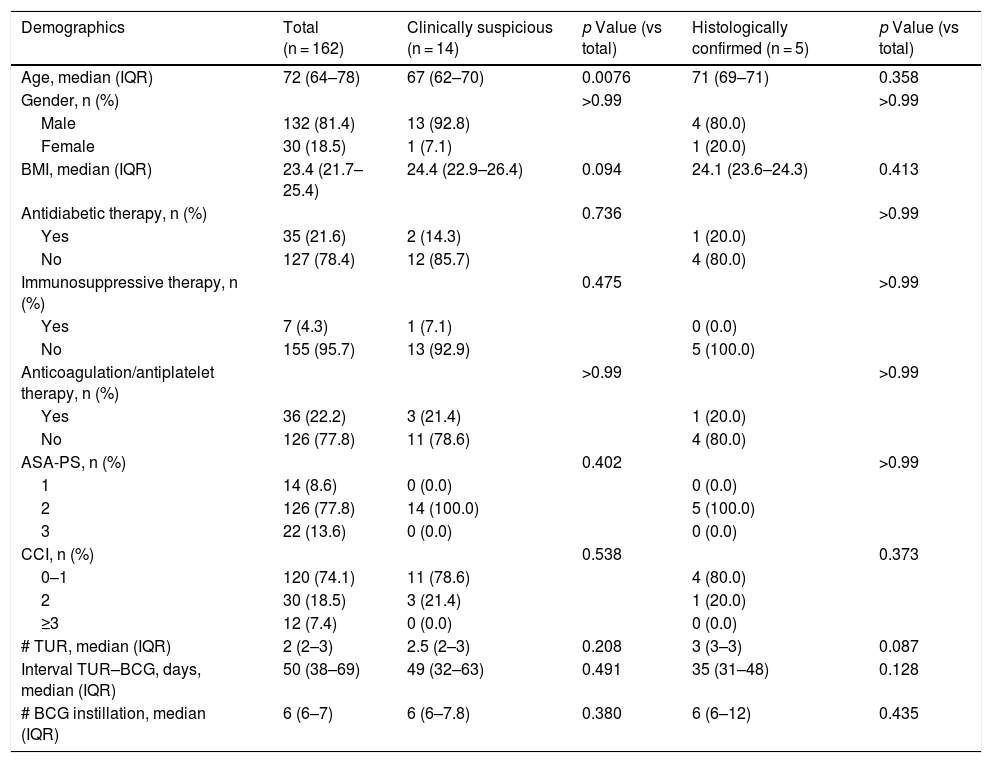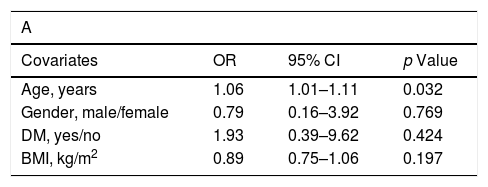Although the complications of intravesical BCG treatment are well described, asymptomatic genitourinary granulomas after BCG therapy have rarely been reported and management strategy for these conditions remains controversial. The objective of this study is to evaluate the incidence rate of asymptomatic genitourinary granuloma formation mimicking bladder cancer recurrence after intravesical bacillus Calmette-Guérin (BCG) therapy and to identify the diagnostic and treatment strategies according to patient conditions.
Patients and methodsA retrospective review was conducted on 162 patients who underwent intravesical BCG therapy. For patients who developed granulomas, we evaluated the time interval between BCG instillation and the development of granuloma, the presence of acid-fast bacteria on pathology specimens, culture/polymerase chain reaction results, management strategies for the lesions, and clinical outcomes.
ResultsAsymptomatic genitourinary masses developed in 14 patients, of whom 5 underwent histological examinations and all were confirmed to have granulomatous inflammation. The affected organs included the kidney, bladder, prostate, and penis. While four of the five patients did not receive treatment for their granulomas, one patient was administered antituberculous medication to prevent worsening of the lesion during the perioperative period of the scheduled cystoprostatectomy. None of the patients experienced worsening or recurrence of granulomatous lesions. Patients who developed asymptomatic masses (n = 14) were significantly younger than those who did not (p = 0.0076) and multivariate analysis also showed that younger age was independently associated with the development of clinically suspicious lesions (p = 0.032); however, none of the parameters were associated with histologically confirmed granuloma formation.
ConclusionsGenitourinary granulomas mimicking recurrence of carcinoma may develop in nearly 10% of patients after intravesical BCG therapy. Most patients can be managed without potentially toxic antituberculosis therapy.
Aunque las complicaciones de la terapia intravesical con BCG están bien descritas, pocas veces se ha comunicado la formación posterior de granulomas genitourinarios asintomáticos, y su estrategia de tratamiento sigue siendo controvertida. El objetivo de este estudio es evaluar la tasa de incidencia de la formación de granulomas genitourinarios asintomáticos que imitan la recurrencia del cáncer de vejiga tras el tratamiento intravesical con el bacilo de Calmette-Guérin (BCG), así como identificar las estrategias de diagnóstico y tratamiento según las características de los pacientes.
Pacientes y métodosSe realizó una revisión retrospectiva de 162 pacientes sometidos a terapia intravesical con BCG. En los pacientes que desarrollaron granulomas, se evaluó el intervalo de tiempo entre la instilación de BCG y el desarrollo del granuloma, la presencia de bacterias acidorresistentes en las muestras de patología, los resultados del cultivo/reacción en cadena de la polimerasa, las estrategias de tratamiento de las lesiones y los resultados clínicos.
ResultadosSe desarrollaron masas genitourinarias asintomáticas en 14 pacientes, de los cuales 5 se sometieron a evaluaciones histológicas confirmando en todos los casos una inflamación granulomatosa. Los órganos afectados fueron el riñón, la vejiga, la próstata y el pene. Aunque cuatro de los cinco pacientes no recibieron tratamiento para los granulomas, a uno de ellos se le administró medicación antituberculosa para evitar el empeoramiento de la lesión durante el periodo perioperatorio de la cistoprostatectomía programada. Ninguno de los pacientes experimentó empeoramiento o recurrencia de las lesiones granulomatosas. Los pacientes que desarrollaron masas asintomáticas (n = 14) eran significativamente más jóvenes que aquellos en los que no se produjeron (p = 0,0076), y el análisis multivariante también mostró que la edad más joven se asociaba de forma independiente con el desarrollo de lesiones clínicamente sospechosas (p = 0,032); sin embargo, ninguno de los parámetros se asoció con la formación de granulomas confirmados histológicamente.
ConclusionesLos granulomas genitourinarios que imitan la recurrencia del carcinoma pueden desarrollarse en cerca de un 10% de los pacientes sometidos a terapia intravesical con BCG. En la mayoría de los casos, el manejo de los pacientes puede realizarse sin una terapia antituberculosa potencialmente tóxica.











